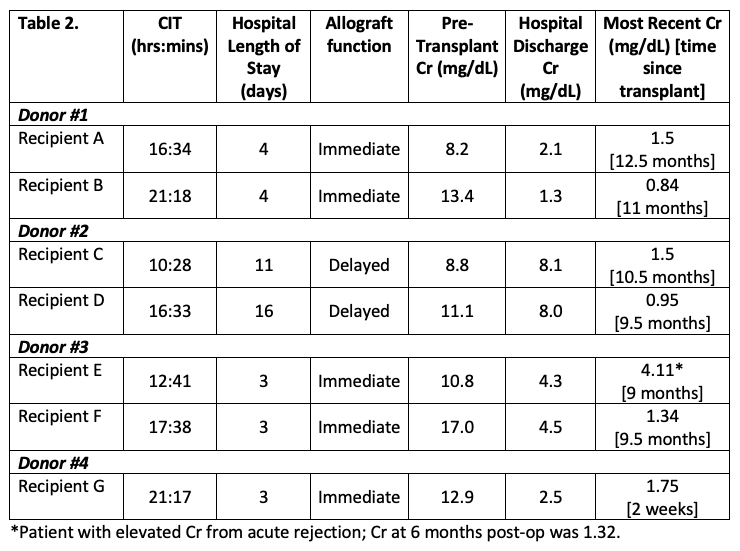Feasibility and Short-Term Outcomes of Kidney Transplantation Following Donation After Circulatory Death Using Thoracic Normothermic Regional Perfusion in the United States
Surgery, Vanderbilt University Medical Center, Nashville, TN
Meeting: 2022 American Transplant Congress
Abstract number: 395
Keywords: Circulatory Death, Graft survival, Kidney, Procurement
Topic: Clinical Science » Kidney » 32 - Kidney Deceased Donor Selection
Session Information
Session Name: Kidney Deceased Donor Selection II
Session Type: Rapid Fire Oral Abstract
Date: Tuesday, June 7, 2022
Session Time: 3:30pm-5:00pm
 Presentation Time: 4:10pm-4:20pm
Presentation Time: 4:10pm-4:20pm
Location: Hynes Ballroom C
*Purpose: Organ donation after circulatory death (DCD) is an important component of kidney transplants in the US. Cardiac transplantation from DCD donors has previously been limited to local donors due to allograft dysfunction with prolonged cold ischemia time (CIT). The use of thoracic normothermic regional perfusion (TA-NRP) is a novel approach in the US that allows for longer cardiac allograft CIT and a larger potential donor pool. The effect of TA-NRP on kidney allograft viability and outcomes is unknown, though the European experience has shown promise in using abdominal NRP (A-NRP) to decrease rates of primary non-function and delayed graft function (DGF) after DCD. To our knowledge, this is the first report of kidney outcomes from donors undergoing TA-NRP for DCD cardiac donation.
*Methods: We retrospectively examined the outcomes of four DCD donors using modified ECMO (with exclusion of cerebral circulation) to achieve TA-NRP prior to standard flushing with cold preservation solution.
*Results: All donors were Caucasian males ages 18-38 with BMI less than 31 that died from trauma; one donor was hepatitis C viremic. Times from withdraw of life-sustaining therapies (WLST) to NRP and terminal creatinine (Cr) are provided in Table 1.
Seven kidneys were transplanted at our center (the eighth was transplanted elsewhere) and all are functioning at most recent follow-up (Table 2). Recipient renal disease was secondary to diabetes (n=3), hypertension (n=3), or polycystic kidney disease (n=1). Average recipient BMI was 37 (range 32 – 42). All kidneys were imports with over 2 hours travel time. Two recipients had DGF: one received 2 sessions of hemodialysis (HD) POD#0 and 7 for hyperkalemia and the other received HD POD#6 for hyperkalemia and peritoneal dialysis POD#6-14 for volume management, after which they had steadily improving function.
*Conclusions: This small series shows that TA-NRP as a strategy to increase the DCD cardiac donor pool is not harmful to potential kidney allografts and could be beneficial similar to A-NRP. We plan to study outcomes from TA-NRP DCD donors when compared to standard DCD and DBD donors in the future.
To cite this abstract in AMA style:
Hickman L, Shaffer D, Hoffman J, McMaster WG, Shah AS, Forbes R. Feasibility and Short-Term Outcomes of Kidney Transplantation Following Donation After Circulatory Death Using Thoracic Normothermic Regional Perfusion in the United States [abstract]. Am J Transplant. 2022; 22 (suppl 3). https://atcmeetingabstracts.com/abstract/feasibility-and-short-term-outcomes-of-kidney-transplantation-following-donation-after-circulatory-death-using-thoracic-normothermic-regional-perfusion-in-the-united-states/. Accessed December 22, 2025.« Back to 2022 American Transplant Congress


